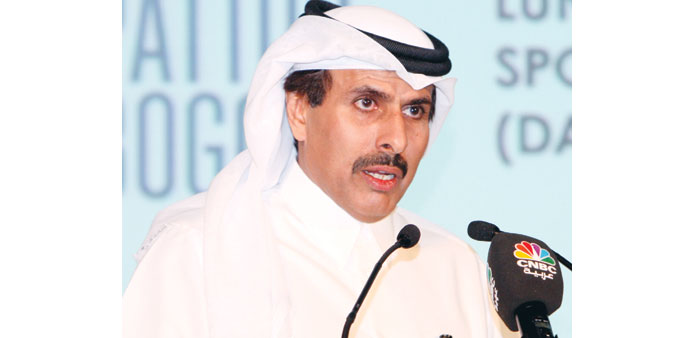By Pratap John/Chief Business Reporter
Qatar’s sustainable growth is reflected in the performance of the country’s banking system in 2012, Qatar Central Bank Governor HE Sheikh Abdullah bin Saud al-Thani has said.
The combined assets of the commercial banks in the country totalled QR817bn last year, up 18% on 2011, Sheikh Abdullah said in his address at the Meed Qatar Projects Conference at the Grand Hyatt yesterday.
Deposits with the local banks in 2012 totalled QR458bn, up 26% on 2011. Credit facilities extended by local banks surged by 27% last year to QR477bn.
“Even as the country’s banking sector grew, it was able to contain the non-performing loans,” Sheikh Abdullah said.
The ratio of non-performing loans to total loans remained low at 1.7% last year, which reflects on the quality of assets with the commercial banks in the country.
Sheikh Abdullah said preliminary estimates indicated that the country’s GDP (at current prices) grew by 11% last year to QR700bn.
He said the Qatar National Vision 2030 aimed at establishing a risk-free financial system in the country. A lot of measures are being taken to achieve this. Important among these is the realigning the regulatory framework so that banks, insurance firms, investment companies and stock markets are properly regulated. Another step is to revitalise the country’s capital market.
Also, a Credit Bureau and a Financial Stability Department have been set up under the QCB. These are all aimed at ensuring a risk-free financial system in the country.
Sheikh Abdullah expected Qatar’s real GDP growth to be around 5.5% in 2013.
In its recent country outlook, the International Monetary Fund said Qatar’s economy is expected to grow by 5.2% this year with “strong economic outlook” in the medium term mainly on the back of robust non-hydrocarbon growth.
The IMF has estimated the country’s nominal GDP will exceed $191bn this year from $184.7bn in 2012.
On the country banking system the IMF said it “remains highly capitalised and profitable.”
The capital adequacy ratio of commercial banks rose from 16.1% in 2010 to 21.1% in June 2012, while nonperforming loans declined from 2% to 1.7% over the same time period, and the return on assets recording 2.5% in June 2012. On the other hand, the IMF underscored the need to reduce the build-up of liquidity and currency mismatch risks and to prevent the accumulation of excessive exposure to the real estate sector.
The IMF welcomed the Qatari authorities’ efforts to develop a deep and liquid domestic debt market, which will bring important benefits in financing, monetary transmission and liquidity management.



